 Leading Blog | Posts by Month |
 Leading Blog | Posts by Month |
04.30.21

LeadershipNow 140: April 2021 Compilation
See more on
Posted by Michael McKinney at 11:00 AM
04.29.21

Leading Thoughts for April 29, 2021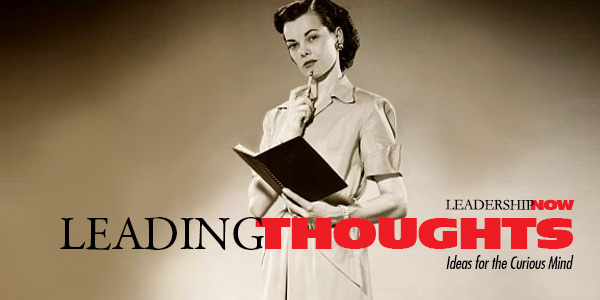
IDEAS shared have the power to expand perspectives, change thinking, and move lives. Here are two ideas for the curious mind to engage with: Phil Knight on competition: “Emotion would be fatal. I needed to remain cool. I thought back on my running career at Oregon. I’d competed with, and against, men far better, faster, more physically gifted. Many were future Olympians. And yet, I’d trained myself to forget this unhappy fact. People reflexively assume that competition is always a good thing, that it always brings out the best in people, but that’s only true of people who can forget the competition. The art of competing, I’d learned from track, was the art of forgetting, and I now reminded myself of that fact. You must forget your limits. You must forget your doubts, your pain, your past. You must forget that internal voice screaming, begging, ‘Not one more step!’ And when it’s not possible to forget it, you must negotiate with it. I thought over all the races in which my mind wanted one thing, and my body wanted another, those laps in which I’d had to tell my body, ‘Yes, you raise some excellent points, but let’s keep going anyway…’” Source: Shoe Dog: A Memoir by the Creator of Nike Randy Komisar on personal success: “Considering personal risk forces us to define personal success. We may well discover that the business failure we avoid and the business success we strive for do not lead us to personal success at all. Most of us have inherited notions of "success" from someone else or have arrived at these notions by facing a seemingly endless line of hurdles extending from grade school through college and into our careers. We constantly judge ourselves against criteria that others have set and rank ourselves against others in their game. Personal goals, on the other hand, leave us on our own, without this habit of useless measurement and comparison. Source: The Monk and the Riddle: The Education of a Silicon Valley Entrepreneur Look for these ideas every Thursday on the Leading Blog. Find more ideas on the LeadingThoughts index.
Posted by Michael McKinney at 07:42 AM
04.27.21

The FBI Way: The Seven C’s of Excellence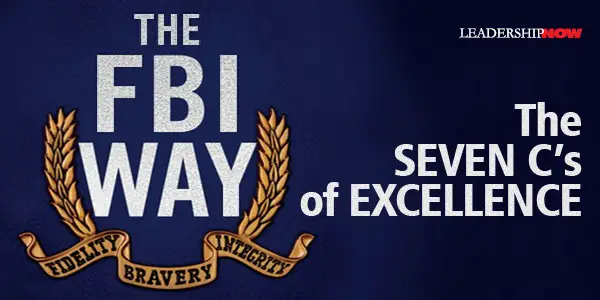
THE Federal Bureau of Investigation is a respected American institution that had its beginnings in 1908. Its 100-plus years of exceptional performance, the former head of counterintelligence Frank Figliuzzi says, is attributed to the organizational code that demanded internal excellence at all times, from everyone. He calls it the FBI Way. In The FBI Way: Inside the Bureau’s Code of Excellence, Figliuzzi organizes and explains that code and how it is maintained as The Seven C’s. These seven values are worth considering in any context. 1. Code The code reflects the core values that are shared by everyone in the organization. If you haven’t established basic behavioral benchmarks in your business, organization, team, or family, you should. They don’t have to be numerous; in fact, they shouldn’t be. Too many rules can very quickly turn into no rules at all. Determine what type of conduct so undermines whatever you or your group stands for that it poses an existential threat. Communicate those “danger zones” clearly and frequently. The FBI, as an institution, enforces code and investigates deviations from that code—the U.S. Constitution and the criminal code. Living out their own code becomes critical to that process, especially in a political environment with really no code. You can’t live by two codes at once. You also can’t spot and avoid the kinds of codes and conduct that threaten your values if you never even develop a strong sense of what it is that you value. You’ll never see the threat coming. We might not die from an absence of code, but regardless of who we are, our lives and livelihoods are enhanced when we know what we stand for. 2. Conservancy The FBI is a conservancy. I like his terminology here. Like stewardship, conservancy is “a collective effort to preserve and protect the true worth of a place or thing. People in conservancy agree to become stewards accountable for sustaining an entity greater than themselves.” Accountability is key here. And everyone in the FBI is accountable to someone, and the higher up you go, the more accountable you are. He briefly mentions the missteps of Jim Comey in 2017. Comey cast doubt on the FBI when he allowed himself to be drug into the political drama of the time. It’s human, but Figliuzzi says it basically came down to the fact that he forgot who he was accountable to. It is hard not to become political, even when writing a book such as this, but it is critical to the FBI’s credibility that it is not seen as political. As Figliuzzi advises later in the book, “Sometimes taking a broader view of your mission can help you preserve your values.” Figliuzzi notes that families need conservators too. And his wife filled that role. 3. Clarity Clarity applies in a number of ways. Clarity includes “bright lines;” Those lines, that when crossed, get you fired. Clarity of code. The need for clarity of information for decision making and the clarity to know when you have enough or all you are going to get. “You need to know when to demand clarity and when to just walk away.” And there is the clarity of purpose and principle that help you to know when to say yes and when to walk away. Too often, when organizations have their most important standards challenged, they engage in a cost-benefit analysis to decide whether to defend their core values. Those organizations don’t recognize that standards worth defining are standards worth defending. 4. Consequences There should be no surprises when it comes to consequences. A code must have repercussions when it is violated, or it is just “window dressing.” A code that’s not enforced quickly becomes a lie that undermines your entire operation. You can’t just wish a code into compliance; people need to understand that there’s a price to pay if they endanger the collective health of the larger team. Consequences put teeth in a code. 5. Compassion A code without compassion doesn’t work for long. Compassion and consequences go hand-in-hand. Sometimes compassion means looking in the mirror to see how you or a dysfunctional system lead to the poor judgment or wrong behavior. Compassion provides the necessary balance to what could be an otherwise harsh and cold process. As sure as people need to know that their leaders have set bright lines on conduct, they also need to trust that those leaders will treat them as valued human beings. That’s why good leaders take a holistic approach to weighing consequences by assessing an employee’s total record, the context that led to their lapse, and that team member’s capacity to overcome their wrongdoing. 6. Credibility Credibility is the bedrock of a values-based organization or group. And that applies both within the organization and about the organization. “People must believe in us and the values we represent. It is credibility that determines whether values survive beyond the personalities of individual leaders.” Credible preservation of principles happens when the process is codified, objective, and comprehensive. Codification means the process must not only be in writing but also easily accessible, understandable, and taken seriously. 7. Consistency Consistency is about intentionality. It helps to preserve what really matters. There was a beauty and simplicity to establishing a rhythm that went beyond mere routine. I’m talking about developing a system in your life, your work, or your studies, and sticking with it if it works, or tweaking it if it doesn’t. A consistent system. Not just winging it. But as Figliuzzi points out, that shouldn’t be confused with rigidity. Consistency may mean, at times, redefining “your entire approach in order to remain consistent with your values,” as they did after 9/11. Change shouldn’t be something that happens “to” people, it should be something that happens “with” people. It’s crucial that everyone involved understand that adapting doesn’t mean an abandonment of values or mission. To the contrary, the proposed changes must reflect how those changes are not only consistent with your values but vital to preserving them. He observes that the “FBI’s highest-profile mistakes happen primarily when its leaders act contrary to their own rules.” So build in systems that make it harder to fail. Woven into the explanation of each of these qualities are stories of 9/11, interstate chases, Quantico, anthrax, espionage, counterterrorism, homicides, and much more to illustrate his point. The FBI Way is a very profitable and interesting read. And well worth your time for the principles that are applicable anywhere. 
Posted by Michael McKinney at 11:22 PM
04.23.21

Hot Seat: Jeff Immelt at GE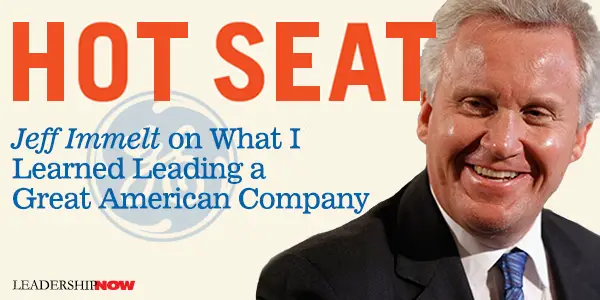
IN SEPTEMBER 2001, Jack Welch was a tough act to follow. The day after Jeffrey Immelt became CEO of General Electric, he had an even bigger challenge to deal with—the 9/11 terrorist attacks. Immelt states in Hot Seat: What I Learned Leading a Great American Company: The best leaders absorb fear. I’m not talking about soothing people by blowing smoke or giving false assurances. I’m talking about giving people the truth but also giving them a way forward. In the wake of 9/11, GE’s people needed to hear, and to believe, that we had a plan and that, working together, they could help us execute it. They didn’t need to hear that I was so agitated that I struggled to keep food down. That’s baptism by fire. Jack Welch led GE to some impressive numbers. In his twenty years as CEO, GE’s value had risen 4,000 percent. But numbers can hide looming issues until they don’t. GE had internal problems, it was overly reliant on GE Capital, and it was not digitally literate and innovative. And in 2001, the economic tailwinds that Welch enjoyed were about to shift. Much of what needed to be done at GE were long-term propositions. It’s always a challenge to help the naysayers within your own ranks, let alone helping the investors and pundits understand the value of what needs to be done. This was the case with GE Digital, a new subsidiary created to provide software and Industrial Internet of Things services to industrial companies. Tech start-ups define success, especially in the first decade, on how well they acquire customers, build capability, and penetrate their emerging markets. That wasn’t how GE had traditionally defined success. We were about increasing revenues and making our numbers. Analyzed by that metric, this little start-up within a big parent company was seen by many as a disappointment. Immelt gives us an inside look—the other side of the story—at what happened at GE while he was CEO. He reveals the complexities of running a global company of over 200,000 employees. I don’t think if Welch stayed on, it would have been much different. Times were changing, hidden problems were beginning to surface, and unforeseen events were to impact the nation. What Welch built was not sustainable. There were lapses in judgment (Yes, he talks about the chase plane) and mistakes made, to be sure, as he admits in this book. GE Capital should have been reined in faster for one thing. Acquisitions were made in an attempt to move GE in a new direction in accordance with the marketplace and to shore up businesses GE was already in. When stock value drops 30% on your watch, you can bet people are looking for a scapegoat. It’s easy to point fingers and have all of the answers from the sidelines, but when you’re actually in it working through the ambiguity, it’s another story. That should be a lesson for all of us. Some people point fingers in a crisis, others solve problems, and there’s very little overlap between these two groups. In a blaming culture, people can stop working in order to cover their own asses. If you can nurture an ethos of “all for one and one for all,” it can save your bacon. Good people will stand alongside you in a righteous fight. When you have a strong team, you can weather any crisis. Without that, you are lost. Jeff Immelt and his co-author Amy Wallace have written a very readable, inside look at Immelt’s 16 years as CEO of GE. There are many lessons and takeaways to be found inside. Immelt is now a partner at New Venture Associates, a Silicon Valley venture capital firm. He also lectures at the Stanford Graduate School of Business. “The media always look for a single person, a CEO or an entrepreneur, to personify the accomplishemnts of an entire company or industry. It makes good reading, but it’s simplistic.” 
Posted by Michael McKinney at 03:50 PM
04.22.21

Leading Thoughts for April 22, 2021
IDEAS shared have the power to expand perspectives, change thinking, and move lives. Here are two ideas for the curious mind to engage with: Economist Tim Harford on the problem of using statistical metrics as a proxy to control or as a target to be improved: “Social scientists have long understood that statistical metrics are at their most pernicious when they are being used to control the world, rather than trying to understand it. Economists tend to cite their colleague Charles Goodhart, who wrote in 1975: ‘Any observed statistical regularity will tend to collapse once pressure is placed upon it for control purposes.’ (Or, more pithily: ‘When a measure becomes a target, it ceases to be a good measure.’) Psychologists turn to Donald T. Campbell, who around the same time explained: ‘The more any quantitative social indicator is used for social decision-making, the more subject it will be to corruption pressures and the more apt it will be to distort and corrupt the social processes it is intended to monitor.’” Source: The Data Detective: Ten Easy Rules to Make Sense of Statistics Jon Acuff on the things we tell ourselves—our soundtracks: “One of the greatest mistakes you can make in life is assuming all of your thoughts are true. We tend to believe that if it’s in our head, it must be accurate. If I think it, it must be real. Despite the wild things our thoughts have told us over the years, we trust them. When you start to ask a soundtrack this question—is it true?—I promise you’ll be shocked by how many lies you have cluttering up your head.” Source: Soundtracks: The Surprising Solution to Overthinking Look for these ideas every Thursday on the Leading Blog. Find more ideas on the LeadingThoughts index.
Posted by Michael McKinney at 11:55 AM
04.19.21

What You Do Is Who You Are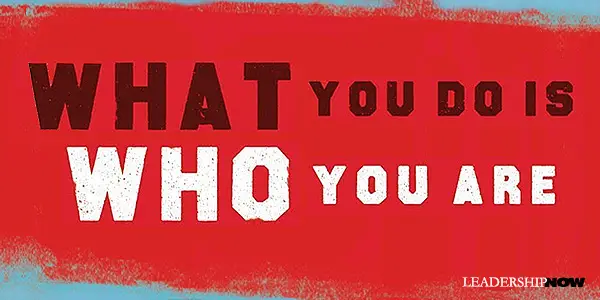
IT HAS BEEN SAID that culture is the most important thing because it determines how your company makes decisions when you’re not there. This led Ben Horowitz to ask, how do you create and sustain the culture you want? He turned to three historical figures and one contemporary that were “outstandingly effective in getting the culture they wanted.” He wasn’t so interested specifically in the culture they produced but what they had to do to change themselves and their culture. In What You Do Is Who You Are, Horowitz looks at the lives of four cultures created by their leaders: Toussaint Louverture, the Haitian slave that led the only slave revolt in human history. The samurai who ruled Japan for seven hundred years and shaped modern Japanese culture. Genghis Khan, who built the world’s largest empire. Shaka Senghor, and American ex-con who created the most formidable prison gang in the yard and, ultimately, transformed prison culture. Companies—just like gangs, armies, and nations—are large organizations that rise and fall because of the daily microbehaviors of the human beings that compose them.
1. Make sure your culture aligns with both your personality and your strategy. How do you know when something is wrong with your culture? Horowitz point to three indicators: The wrong people are quitting too often, you’re failing at your top priorities, and an employee does something that truly shocks you. Some final thoughts: The best way to understand your culture is not through what managers tell you, but through how new employees behave. What behaviors do they perceive will help them fit in, survive, and succeed? By the way, Peter Drucker’s statement that “culture eats strategy for breakfast” actually speaks the exact point Horowitz is making: “What you do is who you are.” If your culture isn’t aligned with your strategy, then culture rules the day. In the long run, a strategy not supported by culture falls flat. Execution works in concert with culture. 
Posted by Michael McKinney at 08:44 AM
04.16.21

Before You Open a Business…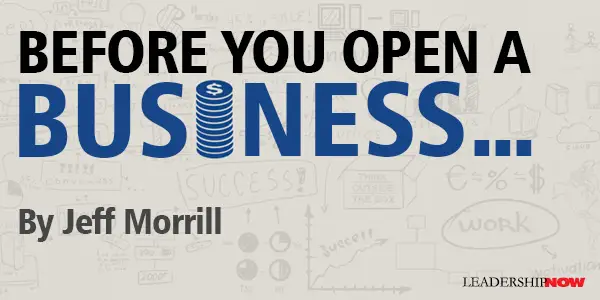
I’VE MET MANY business founders in my life and they vary on almost every possible measure: race, gender, background, temperament, schooling, and intelligence (in all its forms). I certainly observe patterns among them, but they all share one and only one thing in common: they decided to get on the bucking bronco and actually do it. I won’t try to talk you in or out of starting a business. It eventually worked out nicely for us, even with all the sacrifices and tough times along the way. But I’ve seen the pursuit of business opportunities cause irreparable harm to marriages, families, health—and those are some of the successful businesses! A business failure can cause all those problems and many more. For every “American dream” out there, there are more than a few American nightmares. Just because you do the work doesn’t mean the business will work. Some things in business and life are simply out of our control. Bad things happen to good people just as bad things happen to good businesses. There are many ways that even a good business with good leadership can be damaged or bankrupted. Because business is fraught with many risks and challenges, and because this journey isn’t right for everyone, I’ve developed some questions that will help you get more clarity so you can make better decisions for yourself when it comes to starting a business. I resisted the temptation to make it a “quiz” where a certain number of yeses totaled up to give you a red, yellow, or green light. A single “no” to some of these questions might steer you away from entrepreneurship. For example, if your partner isn’t on board, many people might choose to avoid conflicts between “your-wife-or-your-life” or “your-man-or-your-plan.” Others might find that the successful resolution of these conflicts opens them up to new ways of relating to their families and careers. Note that the scale and nature of your business will inform your answers to the following questions. For example, starting a lawn service with a mower and a truck will demand far less investment and risk than borrowing a lot of money to buy an existing landscaping company. Many successful businesses start with a small financial investment and low risk, while others may start with enormous capital, investors that have to be placated, and lots of risk. As you consider these questions, remember the best indicator of how you’ll behave in a future situation is the way you’ve behaved in the past (especially your more recent actions and inactions). For additional insight on the tough ones, ask a close family member or friend who knows you well. Family Questions
Personality Questions
Financial Questions Entrepreneurs reputedly enjoy taking risks. Some do thrive on the adrenaline of working without a net. When I hear about the people who have won and lost multiple fortunes, I think they must enjoy the thrill of rolling the dice. But the majority of the business owners I know prefer to manage risks by minimizing them or bypassing them entirely. Army combat veteran Colonel David Hackworth said, “If you find yourself in a fair fight, you didn’t plan your mission properly.” Most successful entrepreneurs seek the deals where the odds of success significantly outweigh the potential for failure. For many years, I personally bought our used cars at the auctions. By specializing exclusively on Subarus and obsessively immersing myself in that world, I gained a modest competitive advantage over most of the other buyers in the country. I thoroughly understood all the factors that influenced the value of the cars, and I was on the showroom floor every day interacting with the customers who were buying them. Every time I bought a car, I took a bet. Each bet was small enough that even a big mistake would hardly put us out of business, but I piled up the small winnings from all these bets every month until we were buying 100 used cars a month at auctions. I developed a strategy that generated a lot of revenue with minimal risk, although it took a lot of time and effort. You could say I liked to roll the dice, but only when they were loaded in my favor. Imagine you’re the player in an imaginary casino where you can bet on red or black, and you’re right consistently more often than you’re wrong. If you never bet too much to go bust, and you play long enough, you’ll do really well. (This just happens to be the way a real casino makes money from the players.)
 
Posted by Michael McKinney at 08:29 AM
04.15.21

Leading Thoughts for April 15, 2021
IDEAS shared have the power to expand perspectives, change thinking, and move lives. Here are two ideas for the curious mind to engage with: Yale sociologist and physician Nicholas Christakis reflects on what we are likely to see as we move beyond the COVID-19 pandemic period: “If history is a guide, it seems likely that consumption will come back with a vengeance. Periods of plague-driven austerity have often been followed by periods of liberal spending. If the Roaring Twenties following the 1918 pandemic are a guide, the increased religiosity and reflection of the immediate and intermediate pandemic periods could give way to increased expressions of risk-taking, intemperance, or joie de vivre in the post-pandemic period. The great appeal of cities will be apparent once again. People will relentlessly seek opportunities for social mixing on a larger scale in sporting events, concerts, and political rallies. And after a serious epidemic, people often feel not only a renewed sense of purpose but a renewed sense of possibility.” Source: Apollo’s Arrow: The Profound and Enduring Impact of Coronavirus on the Way We Live Authors Robert Galford and Anne Drapeau on the correlation between trust and self-knowledge: “Being a trusted leader is about knowing yourself. Knowing your strengths, your shortcomings, what gives you pleasure, what annoys the hell out of you. Knowing why you go to work, why you react as you do under pressure, what scares you, and what makes you proud. The true trusted leaders we know all have one thing in common, if nothing else: they know themselves very well. Self-knowledge is fundamental to be a rusted leader for a simple reason: trust is built on honesty.” Source: The Trusted Leader: Bringing Out the Best in Your People and Your Company Look for these ideas every Thursday on the Leading Blog. Find more ideas on the LeadingThoughts index.
Posted by Michael McKinney at 03:29 PM
04.12.21

6 New Rules for the Digital Age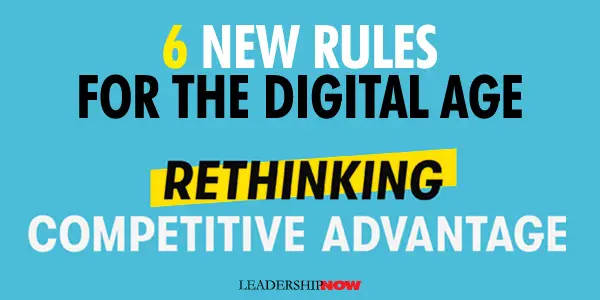
EVERY NOW AND THEN, a book comes along to give you the insights you need to see and understand the world you live in and how to thrive in it. Rethinking Competitive Advantage: New Rules for the Digital Age by Ram Charan is one of those books. The ideas and terminology you’ve heard and read about come together here to give you a holistic view of where you need to go next. Charan has taken years of observation and distilled it into six practical rules to guide you into this digital age. To begin: In the digital age, competitive advantage is the ability to win the ultimate prize—the consumer’s preference—repeatedly, through continuous innovation on behalf of the consumer, and to create immense value for the shareholders at the same time. As opposed to: Until recently, the greatest competitive advantage went to companies that controlled distribution channels, had hard assets on the largest scale, or had established brands or patents. In other words, it’s more about what a company does than what it has. Digitization defines the playing field. “The old adage ‘stick to your knitting,’ for example, a colloquial version of ‘build on your core competence,’ tends to narrow a company’s imagination. Yet a bold imagination is a requirement for leaders today.” Digital companies like Netflix, Amazon, Google, and Alibaba, have certain elements—or approaches—in common: • They imagine a 100x market space that doesn’t yet exist.
These elements lead to six rules that a leader must work with if they are going to thrive in the digital age. The way forward is understanding the new rules of competition and playing a different game. Charan explains several roadblocks like—an overreliance on outdated theories—to moving forward in the digital age that insightful. The first four rules represent building blocks for building a competitive advantage. The last two relate to the human side of bringing this all together. Rule #1. A personalized consumer experience is key to exponential growth. The digital companies connect with the end-user and creating a customized experience. They work from the end-user backward. The customer is not the retailer but the end-user. “The key is to identify an experience that can both be personalized and appeal to a very large number of people, regardless of national or cultural boundaries.” Most traditional companies don’t think big enough. Rule #2. Algorithms and data are essential weapons. Algorithms and data must become central to your business. Charan distinguishes digital capability and digital platform. Digital capability usually means that the company has utilized algorithms to improve internal processes. In contrast, a digital platform is “a set of algorithms that collect and analyze data. Combining and refining algorithms over time helps a company build a competitive advantage.” Converting to a digital platform should be done incrementally. Leaders must understand what technology can do for them and have good judgment about how to use it. A digital platform can personalize the consumer experience, create market spaces of 100x, eliminate intermediaries, utilize dynamic pricing, and use data to uncover opportunities for exponential growth. Rule #3. A company does not compete. Its ecosystem does. The ecosystem is the arrangement between partners that can be created. “Moving forward requires seamless systems and technology platforms, taking advantage of the latest technical developments, meeting a range of consumer preferences, and processing massive amounts of data to improve the outcome of things.” Conceiving these ecosystems takes imagination and a specific set of leadership skills. Fundamentally, “it’s about building relationships with people from other cultures and with different incentives.” The predominant challenge is to conceive of the ecosystem in its entirety, how it will deliver a great experience for the consumer, how the partners will enhance each other capabilities, and how success will be measured and shared. Rule #4. Moneymaking is geared for huge cash generation, not earnings per share, and the new law of increasing returns. Funders understand the difference. When it comes to digital companies, earnings per share is not the focus. Revenue growth and cash gross margin is. Moneymaking is different in the digital age. Of course the components of moneymaking—things like revenues, cash, gross margin, cost structure, and funding—are the same as ever. But the emphasis, the patterns, the timing, and the relationships among them are different. In digital companies, as revenues grow, so does gross margin because of the law of increasing returns. As digital companies grow revenues and improve percentage gross margin, they exponentially increase their gross margin in cash. In essence, they become a cash-generation machine. The digital connection that digital companies have with their customer base makes it easier for them to keep them engaged and gather more data. “Algorithms can then help detect the causes of certain behaviors, including customer defections, and test ways to improve the customer experience.” Rule #5. People, culture, and work design form a “social engine” that drives innovation and execution personalized for each customer. The social engine, a company’s culture and way of organizing work, helps drive the growth of the big digital companies. Most of these digital giants operate with only three or four layers below the CEO. Organizing into functionally focused teams makes for better and faster decisions and implementation. Important too is who is on those teams. Who you choose to lead those teams speaks volumes about the values of the company. Beyond just plain competency, you need people who want to learn, grow, and get things done. Laslo Bock said that at Google, they “disqualified anyone who gave even a small signal that they might not be collaborative or intellectually humble.” Once established, the culture becomes a magnet for others who share those values and behave that way. Rule #6. Leaders continuously learn, imagine, and break through obstacles to create the change that other companies must contend with. Speaking of intellectual humbleness, leaders must be at the forefront of curiosity and learning—continuously growing. “Any company that is or wants to be digital must have leaders who match up against the criteria a digital company requires.” The main difference Charan sees between traditional leaders of legacy companies versus leaders of digital companies has to do with their “cognition, skills, and psychological orientation.” Among these traits are: They have the mental capacity to think in terms of 10x or 100x, to imagine a future space that doesn’t exist, and the confidence that they will overcome whatever obstacles they might encounter. They have a facility for and are comfortable with data-based analysis. Facts and knowledge—not predictable outcomes—give them the courage to act. There is fluidity to their thinking. They welcome change and even seek it. They are hungry for what’s next and are willing to create and destroy. Their psychology is geared toward high speed, urgency, and continuous experimentation. They are literate in the application of algorithmic science and value fact-based reasoning. They are willing to reconceptualize the organizational structure so that decision-making takes place closer to the customer to improve the speed and quality of decisions. This insightful and very accessible book is one of Charan’s best. It should be widely read. Even if you do not want to join the current reality and perhaps go down with the ship, at least you’ll know why. Here are a few more thoughts from the book: Dissatisfaction with the status quo and a search for what’s next is a universal human endeavor. It does not reside in one person, department, or organizational layer. The flow of ideas cannot be blocked by bureaucratic layers. Do the people at traditional companies welcome change? What happens to the good ideas that emerge? How quickly do they get converted into action? 
Posted by Michael McKinney at 08:52 AM
04.09.21

Mayday! Mayday! How to Build Trust in a Crisis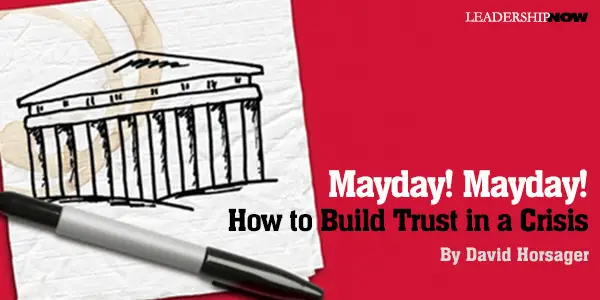
NOTHING reveals an organization’s limits more than a sudden crisis. And after 2020, we’ve all become more familiar with what that looks like. Crisis situations test what you have built — your culture, your relationships, your resilience. But at the root of all of these challenges is one capacity that means the difference between success and failure: trust. Trust is your most important asset amidst crisis and change. A team with high levels of trust will have the agility necessary to make decisions and react quickly to fluctuating situations. Building Trust Instantly The beautiful thing about trust is that it will help you through a crisis even if you start to build it the day things go off the rails. In fact, your quickest opportunity to build trust is in a crisis. On 9-11, complete strangers trusted each other in an instant if they were running in the same direction. To some degree, trust is built up over time, but your ability to build trust multiplies in a crisis. Building trust consists of strengthening eight traits (also called pillars) that came out of research on what makes the most effective leaders and organizations. Take a look at the pillar of clarity for example. Clarity increases trust instantly. It’s almost impossible to trust a leader who is vague or who gives insufficient information. But be crystal clear in your words and your actions, and trust will immediately increase — especially in the middle of a crisis. This three-point strategy prioritizes clarity and provides a roadmap that you can use over and over in any crisis. 1. Narrow your focus to a single priority. When the unexpected hits, everything feels like a priority. But it’s actually the opposite; in a crisis, it’s essential to address only one priority at a time. Ask yourself these two questions to help guide your actions: first, ask “What can I control?” It’s tempting to focus on barriers, but the only thing that matters in a crisis is what you can control, not what you can’t. The second question to ask yourself is “What is the one, most important thing that I can do, right now?” That’s your priority. Designating only one priority means your team will be able to follow through. There’s nothing that builds clarity more effectively than aligning a team around a single, achievable priority. When your team knows exactly where to focus its efforts, trust in your leadership will grow. 2. Compress your plan into short blocks. In a conversation with Gen. McChrystal (best known for his leadership of the US Army Joint Special Operations Command), he shared that when the war in Afghanistan took a turn for the worse, they weren’t able to quickly get the intel they needed. So instead of planning weeks ahead, they set 30-minute daily meetings to define a daily priority. What could this look like in business? Often leaders set a one-year priority, but in a crisis the pace of change means you may need to set a one-month, one-week, or even a one-day priority for your people to follow. In any crisis, task completion is a crucial benchmark because momentum builds momentum. Narrow your priority to something that can be completed in this short timeframe, or shorter! After a week, the situation may have completely transformed. A doable goal also facilitates engagement and optimism. When people know absolutely that their efforts are aligned with a larger plan, they won’t have to waste precious time second guessing or asking for approval. Nothing solidifies trust like a reliable pattern of completion. And the more trust increases, the more smoothly and quickly your operation can run. 3. Maintain agility. Responding to a crisis requires speed, but it also requires flexibility and agility. The situation will change constantly and on a massively accelerated timeframe. The ability to take in information, adjust, and pivot to a new direction is crucial. Once you’ve completed one priority, you need to be able to identify and shift to the next one. The ability to reassess a situation and pivot quickly is just as important as narrowing to a single focus. Leaders must be actively engaged in this process, taking their teams from start to finish, then circling back around to repeat the process. Making it through a crisis unscathed requires organizations to be able to identify, complete, and move on from tasks at a rapid clip. A high trust organization will always be able to move more quickly and maintain solid footing. And nothing facilitates trust better than crystal clear communication. Once you start, clarity builds on itself, and as clarity increases, trust grows exponentially in your leadership and in your business.  
Posted by Michael McKinney at 12:52 PM
04.08.21

Leading Thoughts for April 8, 2021
IDEAS shared have the power to expand perspectives, change thinking, and move lives. Here are two ideas for the curious mind to engage with: The late economic historian professor at the University of California, Berkeley, Carlo M. Cipolla on the five laws of human stupidity: 1. Everyone underestimates the number of stupid individuals among us. Source: The Basic Laws of Human Stupidity Watts Wacker and Jim Taylor on vision: “The only way to succeed in the marketplace today—the marketplace of individuals or products or services or ideas—is to know your own story and to follow it into the future. Define yourself by someone else’s benchmarks, immerse yourself in someone else’s possibilities, and you become the thing you define yourself by and immerse yourself in. Measure yourself against your own rate of change and you stay inside your own story. That way, when the other side ceases to exist, you still have a reason to go on. External and lateral competition is the distraction. Internal and vertical competition is the game. The real battle is against yourself.” Source: The Visionary's Handbook: Ten Paradoxes That Will Shape the Future of Your Business Look for these ideas every Thursday on the Leading Blog. Find more ideas on the LeadingThoughts index.
Posted by Michael McKinney at 11:44 AM
04.05.21

What Leaders Need to Know About Data
SOMETIME between the 1st and 4th century, something incredible happened. Indian mathematicians invented a system for measuring objects. Arabic mathematicians eventually adopted the system, and it was through them that Europe would eventually learn about the numerical system we still use today. Ever since then, numbers have played an important role in our lives. Statistics surround us, and leaders need to have a good grasp of numbers’ roles within their companies. Here are the key things leaders should know about data — and what things they can safely ignore. Data Can Speed Up Decisions The decisions that you make as a leader can have an outsized impact on your company. Data can help you speed up these decisions and ensure that you’re making the correct choices. If you’re exploring a new market to enter, data can provide you with potential projections about sales and give you an idea of the type of customers within this market. The quality of your decisions and the speed at which you make them matter. Look back at the last year, and you’ll realize that it wasn’t just about making the right decision, but doing it rapidly. The entire world went into lockdown within weeks, and leaders had to determine how to shift entire companies into remote work, change how they serve customers and try to figure out how to survive. You can also use data to help your team make better decisions. Leaders know that they need to delegate, but the actual process isn’t always clear. The people under you may not have the same confidence or intuition, but they could be accessing the same information. They could use data to guide them to the right decision without your involvement. Better yet, they can measure the success of their decisions. Data Is Your Flashlight and Map Think about a cave. It’s dark, humid and you can’t see more than a few feet ahead of you. You know there’s an exit somewhere, but you’re not sure how far it is or what path to follow. It would be nice to know the exit direction, but instead, you have a map and a flashlight. And that’s all you actually need! As you lead through uncertainty, think about how your team adjusts to last-minute changes and what kind of map you’re using. The best leaders can quickly create maps for new situations — and better yet, they know when to abandon the map and when to follow it. The new CEO of UPS, Carol Tome, came in with a simple idea: saying “no.” UPS should say no to the wrong customers, wrong product lines and wrong ideas. UPS stock has risen over the last year, and it’s well-positioned to grow beyond the pandemic. I don’t think Ms. Tome knew exactly what might happen under this strategy, but she gave her team a map and flashlight. She trusted that her team could adjust midway through and continue moving towards the exit. Data Can Help You Measure Success Measurement is important in providing options for determining opportunities and new ideas — and determining whether the direction you take is successful. Think about what data you’ll be using to measure progress on your goals. You can explore reports, dashboards and working with specific people to generate the relevant data. Consider also scheduling regular touchpoints to talk about the data and discuss opportunities. What new customer segments are appearing? What products or services should you abandon? Innovation needs to be consciously thought through and carried out. Look at Great Britain’s efforts for funding innovation. It has plans to create its own Defense Advanced Research Projects Agency (DARPA) and give money to innovative ideas. The results are yet to be seen, but it’s moving in the right direction. Leaders are ahead of the pack, trying to scout these innovation opportunities. Numbers have been a blessing and a curse. They’ve given us the ability to understand our world, but they aren't always intuitive. Use data to speed up your decisions, guide you in the dark and measure success. Better yet, use data to become a better leader for your team.  
Posted by Michael McKinney at 06:36 AM
04.02.21

Lead from the Future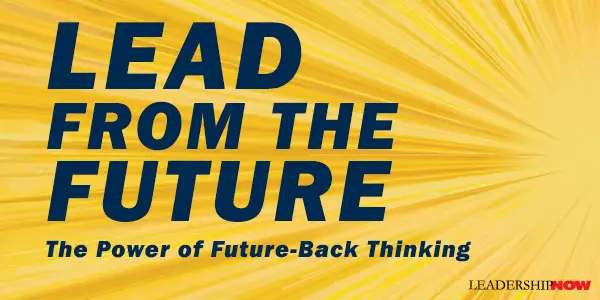
THERE is present-forward vision, and there is future-back vision. There is a difference. Present-forward thinking will get you incremental change and often leaves you stuck in the present. Future-back thinking expands your horizon to see opportunities that are beyond your core business. Future-back helps you quiet the noise today to see the faint signals that could disrupt your business or activities tomorrow. In Lead from the Future, Mark Johnson and Josh Suskewicz describe future-back thinking as “a way of seeing and being in the world.”  While we need to master the present, we can be lulled into thinking that the future will take care of itself because we are making our quarterly numbers. Most founders are future-back thinkers, but “most incumbent organizations are led by people who are much less future-thinking than their founders.” And understandably so, we must succeed in the present. But if we are to survive into the future, we need to be capable of mastering the future too and turn that vision into action today. Present-forward thinking is high in knowledge and driven by known rules, facts, and data; future-back thinking is low in initial knowledge and high in assumptions—its aim is to discover what could be true. The authors offer a three-step process to help leaders develop visionary strategies and bring them to life. 1. Develop Your Vision Identify the potential inflection points in your industry and focus on the timeframe when they are likely to occur. 2. Convert Vision to Strategy To connect your vision of the future to a concrete plan for what you must do today to bring it to life, you need to develop three portfolios: future state portfolio, innovation portfolio, and an investment portfolio. These are “continually updated and tracked as you reshape your vision based on the new learning that comes over time.” The future state portfolio helps you identify your growth gap – what you will need to provide beyond what you are capable of delivering presently to reach your vision. These needed capabilities become your innovation portfolio. Develop an investment portfolio in which you formalize your decisions about where to invest and where your resources will come from. In building it, you should measure dollars but also people and leadership mindshare, as talent and leadership energy are often more scarce in big companies than seed funding. 3. Program & Implement the Strategy Just as a vision needs to be translated into a strategy, a strategy must be carefully programmed into an organization before it can be effectively implemented. The leadership framework shown below highlights the mindsets for both present-forward and future-back leadership. It is not an either/or proposition. The most successful leaders will be those who can do both as needed. A leader described the left side as “serious, disciplined, and self-critical” and the right side as “aspiration, optimism, and risk orientation.”
In The Innovator’s DNA, Clay Christensen identified five attributes that correlate closely with Future-Back Leadership: associating, questioning, observing, experimenting, and networking. Business innovators are sponges for unfamiliar ideas; as such they seek out conferences and other venues to exchange and combine their ideas. Once you understand the principles presented here, you can begin to look at everything with a future-back mindset—including your own life. We need as leaders to have and immerse our teams and organizations with a learning mindset. The tyranny of the present quickly pulls us back into a short-term present-focused mindset. We need to look for the balance and link the present with the future. Future-back needs to become an organizational capability, led at the top, and permanently embedded in leadership mindsets, strategic planning processes, and organizational culture. 
Posted by Michael McKinney at 07:05 AM
04.01.21

First Look: Leadership Books for April 2021Here's a look at some of the best leadership books to be released in April 2021. Don't miss out on other great new and future releases not listed here.
The old ways of creating competitive advantage for your business—such as building moats to ward off competitors—have become dangerous. Giants like Amazon and Alibaba are creating vast new market spaces through a deft combination of tools like machine learning and business savvy that reimagines customer experiences while generating immense shareholder value. A handful of traditional companies, including Fidelity Investments, Walmart, and B2W, have adopted these new approaches to reinvigorate their businesses. Most, however, are stalled—and the clock is running out. In this lively, accessible guide, Ram Charan, bestselling author and adviser to some of the world’s top CEOs and boards, redefines competitive advantage for the digital-first era, offering a set of new rules to get ahead.
Overthinking isn't a personality trait. It's the sneakiest form of fear. It steals time, creativity, and goals. It's the most expensive, least productive thing companies invest in without even knowing it. And it's an epidemic. When New York Times bestselling author Jon Acuff changed his life by transforming his overthinking, he wondered if other people might benefit from what he discovered. He commissioned a research study to ask 10,000 people if they struggle with overthinking too, and 99.5 percent said, "Yes!" The good news is that in Soundtracks, Acuff offers a proven plan to change overthinking from a super problem into a superpower.
When it comes to what we believe, humans see what they want to see. In other words, we have what Julia Galef calls a "soldier" mindset. From tribalism and wishful thinking, to rationalizing in our personal lives and everything in between, we are driven to defend the ideas we most want to believe--and shoot down those we don't. But if we want to get things right more often, argues Galef, we should train ourselves to have a "scout" mindset. Unlike the soldier, a scout's goal isn't to defend one side over the other. It's to go out, survey the territory, and come back with as accurate a map as possible. Regardless of what they hope to be the case, above all, the scout wants to know what's actually true.
As high achievers, we’ve been conditioned to believe that the path to success is paved with relentless work. That if we want to overachieve, we have to overexert, overthink, and overdo. That if we aren’t perpetually exhausted, we’re not doing enough. But lately, working hard is more exhausting than ever. And the more depleted we get, the more effort it takes to make progress. Stuck in an endless loop of “Zoom, eat, sleep, repeat,” we’re often working twice as hard to achieve half as much. Getting ahead doesn’t have to be as hard as we make it. No matter what challenges or obstacles we face, there is a better way: instead of pushing ourselves harder, we can find an easier path. Effortless offers actionable advice for making the most essential activities the easiest ones, so you can achieve the results you want, without burning out.
When we are baffled by the insanity of the “other side”—in our politics, at work, or at home—it’s because we aren’t seeing how the conflict itself has taken over. That’s what “high conflict” does. It’s the invisible hand of our time. And it’s different from the useful friction of healthy conflict. That’s good conflict, and it’s a necessary force that pushes us to be better people. High conflict, by contrast, is what happens when discord distills into a good-versus-evil kind of feud, the kind with an us and a them. In this state, the normal rules of engagement no longer apply. The brain behaves differently. We feel increasingly certain of our own superiority and, at the same time, more and more mystified by the other side. Ripley investigates how good people get captured by high conflict—and how they break free.
 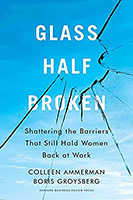 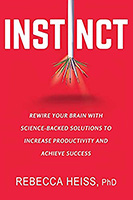
 Build your leadership library with these specials on over 28 titles. All titles are at least 40% off the list price and are available only in limited quantities. “The great thing is to be always reading but never get bored—treat it not like work, more as a vice.” — C. S. Lewis
Posted by Michael McKinney at 08:00 AM

Leading Thoughts for April 1, 2021
IDEAS shared have the power to expand perspectives, change thinking, and move lives. Here are two ideas for the curious mind to engage with: Joseph T. Hallinan on how the tail begins to wag the dog when it comes to our perceptions of reality: “Once we have an opinion about how something should be, that expectation often colors our perception of how that thing actually is. When we look, we look with a purpose—we don’t look at something; we look for something. We tend to see what we expect to see and to experience what we expect to experience.” Source: Kidding Ourselves: The Hidden Power of Self-Deception Paul Zak on how fear-based leadership undermines our goals and dumbs us down: “The science shows that fear-based management is a losing proposition because people acclimate to fear quickly. Fear-inducing leaders must ramp up threats to increase productivity, but there are only so may threats one can make. Source: Trust Factor: The Science of Creating High-Performance Companies Look for these ideas every Thursday on the Leading Blog. Find more ideas on the LeadingThoughts index.
Posted by Michael McKinney at 12:08 AM
|
BUILD YOUR KNOWLEDGE


How to Do Your Start-Up Right STRAIGHT TALK FOR START-UPS 
Grow Your Leadership Skills NEW AND UPCOMING LEADERSHIP BOOKS 
Leadership Minute BITE-SIZE CONCEPTS YOU CAN CHEW ON 
Classic Leadership Books BOOKS TO READ BEFORE YOU LEAD |
|